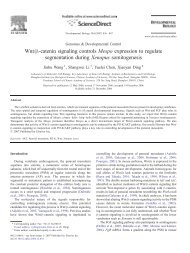Screen PDF - Nucleic Acids Research
Screen PDF - Nucleic Acids Research
Screen PDF - Nucleic Acids Research
You also want an ePaper? Increase the reach of your titles
YUMPU automatically turns print PDFs into web optimized ePapers that Google loves.
3610 <strong>Nucleic</strong> <strong>Acids</strong> <strong>Research</strong>, 2005, Vol. 33, No. 11these mutants are shown in Figure 5 and the kinetic parametersare presented in Table 1. The aminoacylation of the threeU48N (N = A, G, C) mutants increased similarly comparedwith the WT transcript. The results indicate that the increasedaccepting activity of the U48C mutation is due to the secondarystructure rather than a specific residue substitution.The two T-stem double mutants showed greater increases(2.91-fold for U51A/A63U and 2.13-fold for G52A/C62Uas compared with that for WT transcript) in charging efficiency(k cat /K M ) than those of U48 mutants, suggesting that thestability of Ta alignment and instability of Tb alignment isvery important for the accepting activity. The D48 mutant,which mimicked the shortened variable loop resulting froma T-stem slip, also presented increased plateau level (65%)and charging efficiency (1.61-fold increase relative to WT).It is possible that the shortened variable loop inhibitedT-stem slip, favoring the Ta alignment. Conversely, theU51G mutation that promoted the T-stem slip, favoring theTb alignment, dramatically decreased the charging activityof hmtRNA Leu (CUN). Less than 0.5% of the U51G mutantwas aminoacylated following a 40 min incubation under theexperimental conditions. The U48C/+G54 mutation with the8 nt T-loop, which mimicked the T-loop induced by a T-stemslip, also showed decreased aminoacylation. Neither of thesetwo mutants displayed sufficient aminoacylation to determinethe kinetic parameters. This result suggests that the size ofthe T-loop is critical for the tRNA charging activity in thatcharging capacity is decreased by the addition of bases intothe T-loop, even when T-stem is unchanged. The data suggestthat the negative effect of a T-stem slip on aminoacylation ofhmtRNA Leu (CUN) is due to the increased size of the T-loopinduced by the slip.Figure 3. Comparative enzymatic probing of in vitro transcribed humanmitochondrial tRNA Leu (CUN) and the U48C mutant. (A) Autoradiogramsof the various cleavage products of 5 0 -end-labeled tRNA transcripts separatedon denaturing 12% polyacrylamide gels. Lane C, control incubations withoutprobe; lane L, alkaline ladder; lane G, G ladder. The tRNA was 5 0 -labeledand digested with RNase T1, RNase V1 and nuclease S1. Numbers 1 and 2 referto increasing concentrations of nuclease. The RNase T1 cleavage productspecific for WT transcript was indicated in the solid-line square. The differencecan be easily seen in the dashed-line squares. (B) Result of the enzymaticprobing of WT and U48C mutant hmtRNA Leu (CUN) transcripts. Intensitiesof cuts are proportional to the darkness of the symbols. The pentacle denotesthe specific RNase T1 cleavage at G53 on WT transcript.hmtRNA Leu (CUN). The patterns of enzymatic digestion ofeach tRNA mutant are given in Figure 4B.The charging efficiency of hmLeuRS for each designedtRNA variant was examined. The accepting activities ofDISCUSSIONComparison of the variable loops and T-stems of E.coli (21),Aquifex aeolicus (22) and human cytoplasmic (23) tRNA Leu swith those of hmtRNA Leu (CUN) indicates that there are severalfeatures that determine whether a tRNA Leu s structure isconducive to a T-stem slip. All 5 bp in the T-stem of E.colitRNA Leu (CUG) and A.aeolicus tRNA Leu (CUC) and the 4 bp inthe T-stem of E.coli tRNA Leu (CUC) and human cytoplasmictRNA Leu (CUU) are GC pairs. This high level of GC basepairing in the T-stem stabilizes the Ta alignment and therebyinhibits a T-stem slip in the above tRNA Leu s. A T-stem slip isfurther disabled by the inability of the base at position 48 inthe variable loop to form a base pair with the base at position65 in these tRNA Leu s. Finally, the large size of the variableloops in these Ta stable tRNA Leu s (12–16 nt and 2–4 bp) is ahindrance to a T-stem slip. In contrast, because only 2 of the5 bp of the T-stem are GC pairs in hmtRNA Leu (CUN), the Tastructure configuration is less stable than that in the abovetRNAs. Moreover, in hmtRNA Leu (CUN) U48 exactly pairswith A65 following a T-stem slip, and the variable loop issmaller containing only 4 nt and no base pair. These uniquestructural features of hmtRNA Leu (CUN) enable a T-stem slip.The inherently fragile structure of hmtRNA has been discussedpreviously (24–26). In this work, the structural fragilityof hmtRNA Leu (CUN) is specified as a mechanism of T-stemslip. The T-stem slip can result in a mixture of Ta and Tb







